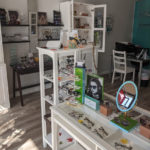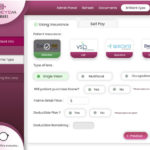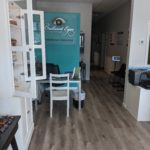
The optical in Dr. Davison’s practice, which moved last year to a new office. The new space is smaller, resulting in substantial cost savings, but the doctor, her staff and patients haven’t had to sacrifice anything.
By Janelle Davison, OD
May 26, 2021
Practice investments can both improve care and the patient experience and significantly boost your profitability. Here are three investments my practice made that changed how we serve patients while making us more cost-efficient and financially strong.
Lens Edger & Blocker
In May 2020, we decided to add a lens edger and blocker to our office. We’re always looking for ways to cut costs on fixed expenses and increase net profit. We saw that one of the ways we could do that was by investing in equipment that would enable us to cut the majority of lenses in-house and allow for the in-house finishing of lenses. We are now able to finish all lenses, even progressives, in-house.
We are able to purchase lenses at the uncut price rather than the finished price. That means we can order stock lenses in bulk. The ability to order stock lenses in bulk, which are finished in-house, dramatically cuts costs. As a result, our monthly lab bill is, on average, 30-35 percent lower now than it was before we had this equipment. Before getting our edger and blocker, one of our monthly lab bills was just under $12,000. Now our monthly lab bill is around $9,000. Our quarterly lab bill prior to purchasing the edger/blocker was $36,000. It is now $27,000.
We paid $30,000 for the edger and blocker, paying cash for it, for which we received a discount. The price we paid included equipment setup and staff training. The cost savings we experienced after making this purchase has allowed us to break even from this investment in just 10 months.
Along with significant cost savings, this equipment has improved our patient experience. We are able to get glasses with single-vision lenses completed and in the hands of patients within 3-5 business days compared to the 10-14 business days it used to take us before having our own lens edger and blocker.
Editors’ Note: To calculate cost of goods when you are finishing your own lenses, we recommend creating a line item in your practice Profit and Loss statement called “Our Finishing Lab” (or any other name that suits you). Into this line item goes everything that it costs you to finish your lenses. Examples are: lens blank fees, staff costs to finish lenses, rent for the working space needed (assign a number based on the space needed in your practice to store product and finish lenses), maintenance agreement fees and equipment repairs and maintenance costs.
In-House Software Solution that Made It Easy for Us to Create Lens Packages
My husband, who has an IT engineering background and is the practice’s chief financial officer, worked with an IT developer to create software, Paradeyem, that allows my staff to input my recommendations for each patient’s lenses, along with the patient’s insurance. The software then instantly calculates what the patient’s out-of-pocket costs will be for their new glasses. There is now no need for our opticians to do these calculations themselves, eliminating the frequent errors in how much patients were charged that we noticed occurring.

The proprietary software system, Paradeyem, which Dr. Davison’s chief financial officer and husband created. The system makes it easy for opticians to input patient information to quickly and accurately calculate patient charges.
This software made it easy for us to create three lens packages, which patients must choose from with the option of adding additional lens treatments to any of the packages, which all include polycarbonate and anti-reflective lenses:
Trendsetter: Polycarbonate AR single-vision or top-of-the market progressive with blue light filter and in-office extended warranty and anti-fog spray.
Premium: Polycarbonate AR single-vision or mid-market option progressive lens.
Basic: Polycarbonate AR single-vision or flattop progressive.
Transitions Lenses and polarized lenses are examples of lens-adds that can be added to any of these packages for an additional fee.
My opticians can now input the co-pays for the patient insurance into the software, along with my recommendations, and the software will tell the patient how much each package will cost them, including the cost for additional lens treatments I may have recommended that are not included in the package the patient chose.
Before we organized our offerings to patients into lens packages, we sold 60 percent AR. Now 100 percent of glasses we sell have AR. We went from 70 percent polycarbonate to 90 percent polycarbonate.
Our average per patient revenue is now $420. Before we had the software system and lens packages, our average per patient revenue was $338.

Dr. Davison’s new office space, which has the feel of a high-end optical boutique and includes dry eye spa services.
Relocating to a Smaller Office
When I first opened my practice, I had an office space of 2,800 sq. ft. My current space, which we moved into in August 2020, is 1,200 sq. ft., and I didn’t have to sacrifice any primary features of my old office when moving into the new. I still have three exam lanes, break room, a nice-sized optical and an eyecare and aesthetic optometry spa where we do advanced dry eye treatment using ThermaEye Plus intense pulse light (IPL), MiBo Thermoflo heat treatments and eyelid cleaning, and where we have an esthetician come in twice a week to do facials, brow waxing and lash extensions. The only feature of the old office I eliminated was a second bathroom. My rent was $5,400 monthly; it is now $3,200 per month.
We also have greater visibility from the street now, as we are five miles closer to the Atlanta city center off a huge road where people bike and jog. We are located now in an area where people frequently come to shop or go to restaurants. Our previous location was in more of a residential area with only grocery stores nearby. This greater visibility is paying off. We have averaged 70 new patients per month for the last six months compared to 55 new patients per month for a six-month period in our old location.
Other Articles to Explore
When I analyzed the layout of my old office, it became apparent that we were wasting tremendous space, taking up space with furniture and plants to hide unused square footage. No square inch of our new space is unused. The ambiance of our office went from feeling like a large family clinic to a high-end boutique. The office also feels different to our patients, as we no longer have to see 20-30 patients per day to cover the cost of our rent. If we generate $4,500 in the optical one day, we have covered the cost of that month’s rent in just one day.
We now see 12 patients per day on average. This means patients get more time with their doctor, and the doctor gets more time to detail all the ways the practice can improve the patient’s life.
 Janelle Davison, OD, is the owner of Brilliant Eyes Vision Center in Smyrna, Ga. To contact her: dr.davison@brillianteyesvisioncenter.com
Janelle Davison, OD, is the owner of Brilliant Eyes Vision Center in Smyrna, Ga. To contact her: dr.davison@brillianteyesvisioncenter.com

























